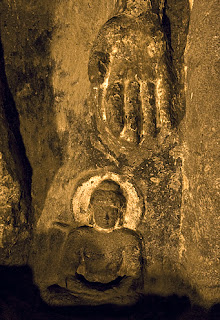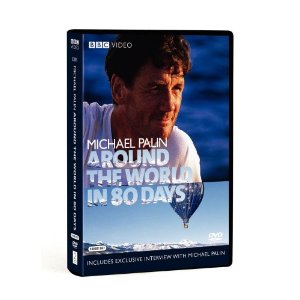I decided to base my packing list for our indefinitely long journey on
Dave Bruno's 100 Things Challenge. I've always loved the idea of having only 100 possessions, and this is the perfect opportunity. Once these 100 things have been set aside, I know everything else has to go: it gets sold, given away, lent or put in storage. Now, having said that, quantity of possessions probably isn't such a big issue for travelers as volume or weight, and in our case, neither is a massive issue. We're planning to avoid planes and stay in most places for several weeks. So this is really just my little game. I don't expect Mike will be joining me. I don't know if I'll even have the stamina to write down everything he brings with him, though it would be interesting - and of course, it would help to prevent things getting lost!
A lot of my packing list has been honed over the years of traveling in all kinds of places but I'm planning to try a few new things as well. This packing list is meant to include the possibility of looking smart in urban environments as well as trekking in the jungle, not doing laundry more than once a week, and coping with a range of temperatures. This is not exactly what I took with me when I went to India!
Bags and carriers
1.
Wallet - with attachment so it fits on a belt.
2.
Satchel bag - suitable for urban life, holds portable office stuff and slides into daypack for easier carrying.
3.
Large wallet - was meant as a pencil case, holds most of the smaller electronics stuff.
4.
Daypack - this was designed as a camera backpack, it has no waist straps, but I love it anyway. I've done a lot of pretty serious day hiking with it, so I haven't been too hampered by the weight-bearing issues.
5.
Soft-sided suitcase - has straps, so it can be carried as a backpack, for short distances anyway.
6.
Cloth shopping/beach bag - useful for shopping, carrying your laundry or taking your stuff to the pool or beach.
7.
Duffel bag for the outdoors stuff - what works for me is to share the suitcase with Antonia, and let everyone's outdoor stuff overflow into a duffel bag.
8.
Stuff bag - for keeping underwear in, and stop it getting mixed up with everything else.
9.
Lunch box - holds food, fragile items, and can double as a plate and bowl in an emergency.
A 10th of the items used already, and it's just bags! Am I crazy? Well, I might be, but I really do use all these things, they mostly pack into each other and don't weigh very much.
Wardrobe list
10.
Underwear - enough for a week. These live in the stuff bag.
11.
Socks - also enough for a week These live in the stuff bag.
12.
Bras - various styles, and also enough for a week. These live in the stuff bag.
13.
Swimsuit - or bikini, I haven't made up my mind yet. But only one of the two.
14.
Blue jeans - I know everyone says leave these out. I would substitute if I were going mainly to very warm, non-Western places.
15.
Black trousers - smart casual, not as heavy as the jeans, suitable for town or hiking.
16.
Dress trousers, black.
17.
Sports trousers - these are more for exercise or hiking and need to be quick drying.
18.
Black long sleeved top
19.
Other-colored long sleeved top - I use these as light sweaters as well, I like to keep them pretty neutral.
20.
Other-colored long sleeved top
21.
Short sleeved black tee-shirt
22.
Other short sleeved tee-shirt - colored, patterned or whatever
23.
Tank top - one fairly smart or pretty top
24.
Tank top - one casual, patterned top
25.
Tank top - plain black
26.
Long-sleeved shirt - mine is a light-colored, Indian shirt from a salwar kameez, with the hem raised to hip level
27.
Long-sleeved shirt - more of a rugged, keep the sun off, trekking shirt with button front.
28.
Sweater - neutral and barely heavier than a long-sleeved top.
29.
Sweater - thicker, and allowed to be interesting.
30.
Shawl - works better for an extra layer, can look smart and can double as a blanket. Or even a bag! I know, I've tried it.
31.
Suede jacket - only because I'm going places where I'm likely to need a light but more urban-style coat
32.
Raincoat - this Gore-tex jacket actually packs up very small, now that its fleece has worn out and been thrown away.
33.
Travel vest - Scottevest travel vest. This is a new experiment, so I'll have to let you know how it works out.
34.
Cocktail dress/tunic - mine is actually the top from my favorite Indian salwaar kameez. It's a very modern style from Mumbai and machine-washable. But I'm planning to wear it with western pants.
35.
Evening dress - well, I'm going to need one, and I've got one that suits me packs small and doesn't crease, so in it goes.
36.
Scarf - belongs with the Indian cocktail 'dress', and like all Indian scarves is broad enough to work as a light shawl, but apart from being a prettyfier, it's great for keeping mosquitoes off, or keeping hair from being windswept.
37.
Leggings or tights - thermal underwear, really, for cold nights.
38.
Pyjamas - ideally, both top and bottom could double as day wear in a pinch.
39.
Belt
40.
Walking shoes - best available compromise between being suitable for hiking and urban life.
41.
Walking sandals - as above. What I hate is when I go in water with them, and they take ages to dry, but I don't feel like hauling plastic shoes right now, so I'll put up with it.
42.
Ballerinas - this is my new experiment in prettier, indoor shoe wear, with the minimum sacrifice of space.
My entire wardrobe is really not much bigger than this, although it has been a struggle finding shoe solutions that worked without taking up too much space or weight.
Toiletries and first aid
43.
Toothbrush
44.
Comb
45.
Nail scissors
46.
Tweezers - this is also an important first aid tool for removing ticks, splinters, ...
47.
Magnifying mirror
48.
Razor
49.
Hair ties
I've had some fun miniaturizing, with the result that all the above fits in my wallet!
50.
Female hygiene products
51.
Deodorant
52.
Laundry powder - for machine washes
53.
Toothpaste - I'm planning to experiment with tooth powder
54.
Shampoo/conditioner - I'm planning to experiment with bar shampoo
55.
Pain reliever
56.
Anti-histamine
57.
Water purification tabs - for replenishments when hiking
58.
Plasters - Compeeds are the best for blisters, we also need some for small cuts and scrapes
59.
Antibiotic wash/cream - for those small cuts and scrapes
60.
Handkerchief/tissues - for the tears that go with the small cuts and scrapes
61.
Insect repellent - frankly, I'm not convinced it works. Barrier methods are more effective, anytime.
62.
Sunscreen - I'm planning to experiment with the dry, stick kind
My new experiment is to try to find dry versions of all the products that are usually runny and tending to escape from their over-sized containers.
Outdoor stuff
63.
Wet suit - I know, this is an outrageous extravagance. How can I justify it, and why don't I just rent one? The reason is that I like swimming in lakes, rivers and seas, but I'm a yellow chicken when it comes to cold water. I use my wetsuit as a substitute swimsuit. And they don't happen to have wetsuit rentals beside any old lake you come across.
64.
Water bottle
65.
Flashlight - the wind up kind. One less battery to worry about.
66.
Thermos
67.
Extra cup for the thermos
68.
Magnifying glass - I really do use it all the time.
69.
Binoculars
70.
Knife - Opinel, a locally produced knife. It will remind me of home.
71.
Compass
72.
Sunglasses - next time I have glasses made, I'm splashing out and getting the kind where the lenses darken.
73.
Hat - broad-brimmed, serious sun prevention hat.
74.
Towel - large enough to preserve modesty, but no larger! It will have to double as a picnic blanket, I think.
We expect to rent tents, sleeping bags, and so on, on occasion.
Electronics
75.
Asus Eee PC netbook - I've had it for about 2 years, and I'm completely delighted with it. Having said that, I need to buy the bigger battery for it, and I do have a time share in the object we're calling the portable desktop, for when I need to work with Photoshop or other graphics things. I hope that time is going to be long enough.
76.
Garmin Oregon 550T gps
77.
Sony Walkman - wth favorite music and Chinese lessons
78.
Canon digital SLR camera + 1 telephoto zoom lens + polarizing filter + card and battery - I count this as one item because it's usually all together. Mike tends to haul a wide angle around so I can swap if needed.
79.
Macro filter for the camera
80.
Spare camera card - I decided to keep it down to two cards to encourage myself to process the photos.
81.
Camera battery charger with spare battery
82.
Generalised battery charger - mostly used for the gps. Ideally, it's power supply would be replaced by a flatter packing one.
83.
Set of spare batteries for the gps
84.
Camera card to computer device - I'm looking for a smaller one
85.
Camera cleaning pen
86.
Telephone - I hate phones. Therefore I'm looking to buy a tiny, contract-free one that charges off the usb port on those rare occasions when I need it.
Papers
87.
Notebook - I use very small ones that fit in my wallet
88.
Field book - this is a sketchbook in which I draw and write
89.
Origami paper
90.
Full pencil case - yes, if I counted each pencil individually, I would fail the 100 things challenge. But I do share with Antonia.
91.
Tiny watercolor set.
92.
Portable filer - this might be a cardboard or plastic sheet system, for the temporary paperwork, tickets and so on that we'll inevitably acquire.
93.
Visiting cards - for people we meet.
94.
Passports - I'm counting them both as one. At least I don't have three, like Antonia.
95.
Driver's licence, and international licence.
96.
ATM cards - also all counted as one
97.
Donor card with medical info such as blood group on it
98.
Eyeglasses - one day to be sun/eye glasses
That's 98 things! For the last two, I can carry any two additional items, a book perhaps?




















